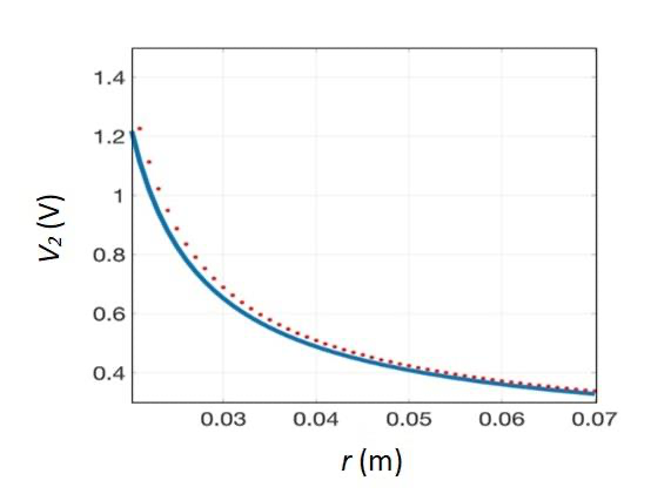Circuitos resonantes de estado sólido y propagación de energía eléctrica inalámbrica para aplicaciones de dispositivos móviles
DOI:
https://doi.org/10.37636/recit.v44314328Palabras clave:
Energía inalámbrica, Circuitos resonantes, Propagación de energíaResumen
En el presente trabajo se presentan resultados teóricos y experimentales de circuitos resonantes de estado sólido para la transmisión y recepción de energía eléctrica inalámbrica, para aplicaciones en dispositivos móviles. Se encuentran expresiones analíticas para calcular el alcance de voltaje en función de la distancia entre el emisor y la carga, así como la corriente en el extremo frontal de un receptor de ondas electromagnéticas. Estas expresiones muestran los parámetros a variar para lograr un mayor alcance en la transmisión de energía eléctrica inalámbrica. La tensión y la corriente transmitidas se miden mediante un receptor de ondas electromagnéticas y se comparan con valores teóricos, encontrando una excelente correspondencia entre ambos.
Descargas
Citas
X. Lu, P. Wang, D. Niyato, D. I. Kim, and Z. Han, "Wireless Charging Technologies: Fundamentals, Standards, and Network Applications," IEEE Commun. Surv. Tutorials, vol. 18, no. 2, pp. 1413-1452, 2016. https://doi.org/10.1109/COMST.2015.2499783. DOI: https://doi.org/10.1109/COMST.2015.2499783
K. H. Yi, "Output voltage analysis of inductive wireless power transfer with series lc and llc resonance operations depending on coupling condition," Electron., vol. 9, no. 4, 2020. https://doi.org/10.3390/electronics9040592. DOI: https://doi.org/10.3390/electronics9040592
P.S. Riehl et al., "Wireless power systems for mobile devices supporting inductive and resonant operating modes," IEEE Trans. Microw. Theory Tech., vol. 63, no. 3, pp. 780-790, 2015. https://doi.org/10.1109/TMTT.2015.2398413. DOI: https://doi.org/10.1109/TMTT.2015.2398413
N. Tesla, "Experiments with altrnate current of very high frequency and their application to methods of artificial illumination," Columbia Coll., pp. 267-319, 1891. https://doi.org/10.1109/T-AIEE.1891.5570149. DOI: https://doi.org/10.1109/T-AIEE.1891.5570149
S. K. Oruganti and F. Bien, "Investigation of Near-Field Wireless Energy Transfer for Through Metal-Wall Applications," 2014 IEEE Wirel. Power Transf. Conf., pp. 247-250, 2014. https://doi.org/10.1109/WPT.2014.6839573 DOI: https://doi.org/10.1109/WPT.2014.6839573
S. Kim, Y. Lim, and S. Lee, "Magnetic Resonant Coupling Based Wireless Power Transfer System with In-Band Communication," no. May 2015, 2013. https://doi.org/10.5573/JSTS.2013.13.6.562 DOI: https://doi.org/10.5573/JSTS.2013.13.6.562
R. Kerid and H. Bourouina, "Analysis of Wireless Power Transfer System with New Resonant Circuit for High Efficiency Using Perforated Capacitors," Arab. J. Sci. Eng., vol. 44, no. 3, pp. 2445-2451, 2019. https://doi.org/10.1007/s13369-018-3579-2. DOI: https://doi.org/10.1007/s13369-018-3579-2
P. Sittithai, K. Phaebua, T. Lertwiriyaprapa, and P. Akkaraekthalin, "Magnetic field shaping technique for HF-RFID and NFC systems," Radioengineering, vol. 27, no. 1, pp. 121-128, 2019. https://doi.org/10.13164/re.2019.0121 DOI: https://doi.org/10.13164/re.2019.0121
R. A. Moffatt, "Wireless Transfer of Electric Power," Massachusetts Institute of Technology, 2009.
T. Supriyanto, A. Wulandari, and T. Firmansyah, "Design and Comparison Wireless Power Transfer Base on Copper (Cu) and Aluminium (Al) Rings Loop Magnetic Coupling," no. January 2016, pp. 6-10, 2017. https://doi.org/10.18178/IJIEE.2016.6.2.605 DOI: https://doi.org/10.18178/IJIEE.2016.6.2.605
C. K. Lee, W. X. Zhong, and S. Y. R. Hui, "Effects of Magnetic Coupling of Nonadjacent Resonators on Wireless Power Domino-Resonator Systems," vol. 27, no. 4, pp. 1905-1916, 2012. https://doi.org/10.1109/TPEL.2011.2169460 DOI: https://doi.org/10.1109/TPEL.2011.2169460
W. Zhou, S. Sandeep, P. Wu, P. Yang, W. Yu, and S. Y. Huang, "A wideband strongly coupled magnetic resonance wireless power transfer system and its circuit analysis," IEEE Microw. Wirel. Components Lett., vol. 28, no. 12, pp. 1152-1154, 2018. https://doi.org/10.1109/LMWC.2018.2876767 DOI: https://doi.org/10.1109/LMWC.2018.2876767
C. M. W. Basnayaka, D. N. K. Jayakody, A. Sharma, H.-C. Wang, and P. Muthuchidambaranathan, "Performance Study of Strongly Coupled Magnetic Resonance," 2019, [Online]. Available: http://arxiv.org/abs/1908.02541.
D. Knight, The self-resonance and self-capacitance of solenoid coils: applicable theory, models and calculation methods, no. May. 2016.
P. Azimi and H. Golnabi, "Precise Formulation of Electrical capacitance for a Cylindrical Capacitive Sensor," J. Appl. Sci., vol. 9, no. 8, pp. 1556-1561, 2009. https://doi.org/10.3923/jas.2009.1556.1561 DOI: https://doi.org/10.3923/jas.2009.1556.1561
H. Wheeler, "Formulas the Skin Effect," Proc. IRE, pp. 412-424, 1942. https://doi.org/10.1109/JRPROC.1942.232015 DOI: https://doi.org/10.1109/JRPROC.1942.232015

Descargas
Publicado
Cómo citar
Número
Sección
Categorías
Licencia
Derechos de autor 2021 Sergio Orendain Castro, Eduardo Murillo Bracamontes, Oscar Edel Contreras López, Alberto Hernández Maldonado

Esta obra está bajo una licencia internacional Creative Commons Atribución 4.0.
Los autores/as que publiquen en esta revista aceptan las siguientes condiciones:
- Los autores/as conservan los derechos de autor y ceden a la revista el derecho de la primera publicación, con el trabajo registrado con la licencia de atribución de Creative Commons 4.0, que permite a terceros utilizar lo publicado siempre que mencionen la autoría del trabajo y a la primera publicación en esta revista.
- Los autores/as pueden realizar otros acuerdos contractuales independientes y adicionales para la distribución no exclusiva de la versión del artículo publicado en esta revista (p. ej., incluirlo en un repositorio institucional o publicarlo en un libro) siempre que indiquen claramente que el trabajo se publicó por primera vez en esta revista.
- Se permite y recomienda a los autores/as a compartir su trabajo en línea (por ejemplo: en repositorios institucionales o páginas web personales) antes y durante el proceso de envío del manuscrito, ya que puede conducir a intercambios productivos, a una mayor y más rápida citación del trabajo publicado (vea The Effect of Open Access).











